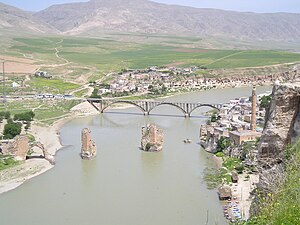|
10,000 YEAR
ANCIENT HASANKEYF
HISTORY RECORDED OF 9 CIVILIZATIONS CLASHES WITH
CURRENT CIVILIZATION NEEDS AT
ILISU DAM PROJECT IN TURKEY
Kurdish Humans Rights
Project: December 16, 2006
The
proposed Ilisu dam, part of Turkey's South-eastern Anatolian Project (GAP),
which has spread a network of dams and power plants across the Kurdish
regions of south east Turkey, threatens more Kurdish homes and livelihoods.
The Ilisu dam will flood an area of 313
square kilometres. No resettlement plan has been agreed, despite the project
having been approved by the Turkish government and conditionally approved
for financial support by the Swiss Export Credit Agency.
The flooding of the ancient city of Hasankeyf,
a town full of historical treasures spanning nine civilizations and
including cave churches, ornate mosques and Islamic tombs, whose history
goes back 10,000 years, will be submerged by the reservoir of the Ilisu dam.
Spanning nine civilizations, the site is of such
archaeological and religious significance that it would clearly warrant
designation as a world heritage site by UNESCO.
The town is of particular cultural significance to the
Kurdish people: the delegation found a widespread perception that the GAP
project, and Ilisu in particular, is motivated primarily by a desire to
destroy the Kurds as an ethnic group by destroying their most important
cultural site
According to Bugday Association, based in Turkey itself,
and which focuses solely on promoting environment-friendly lifestyle and
politics, recent field research conducted jointly by Ms. Huriye Küpeli, the
prefect of Hasankeyf, Swiss ambassador to Turkey and representatives of the
consortium of contractors for the dam project, seem to indicate a suitable
nearby spot for moving the historical heritage of Hasankeyf, an operation
for which the Turkish Ministry of Culture pledges to provide 30 million
euros.
The Ilisu hydro-electric power project is to be situated on
the Tigris river, 65 km upstream from the border with Syria and Iraq. With a
planned capacity of 1,200 MW, it will be the largest hydro-electric project
in Turkey. The project, costing an estimated $2 billion, will be built by an
international consortium, led by Swiss company Sulzer Hydro. Companies in
the consortium include Balfour Beatty (UK), Impregilo (Italy) and Skanska
(Sweden).
|

A woman tending to her home
at the ancient cave village location at Hasankeyf
With the World Bank declining to become involved in GAP projects,
the financing is to be arranged by the Union Bank of Switzerland, with the
Export Credit Agencies of Austria, Germany, Italy, Japan, Portugal, Sweden,
Switzerland, the United Kingdom and the USA currently considering whether to
provide financial support for the project.
It is understood that no alternatives to the relatively
expensive hydro-electricity project have been considered. Yet independent
consultants in Turkey and abroad have stressed that power could be saved at
a lower cost by modernizing Turkey's transmission system. In a climate where
hydro-power is increasingly viewed as a "sunset" industry, alternative
energy technologies, such as solar power, should be considered.
In the light of these findings, the Kurdish Human Rights Project concludes
that international support for the project at this stage would be a
tantamount to support for a human rights disaster. The international
community must pause for thought before committing funds to a project which
threatens to infringe the rights of so many in a region already notorious
for its lack of respect for human dignity.
To get a holistic perspective of this Turkish dilemma please
visit the
Southeastern Anatolia Project web site on Wikipedia by clicking
on the name hilite...
Also click
here
to see a ancient and today's Hasankyf living together as
shown in the photo above in a
photo gallery by Dick Osseman of HASANKEYF AT THE TIGRIS RIVER IN TURKEY |






